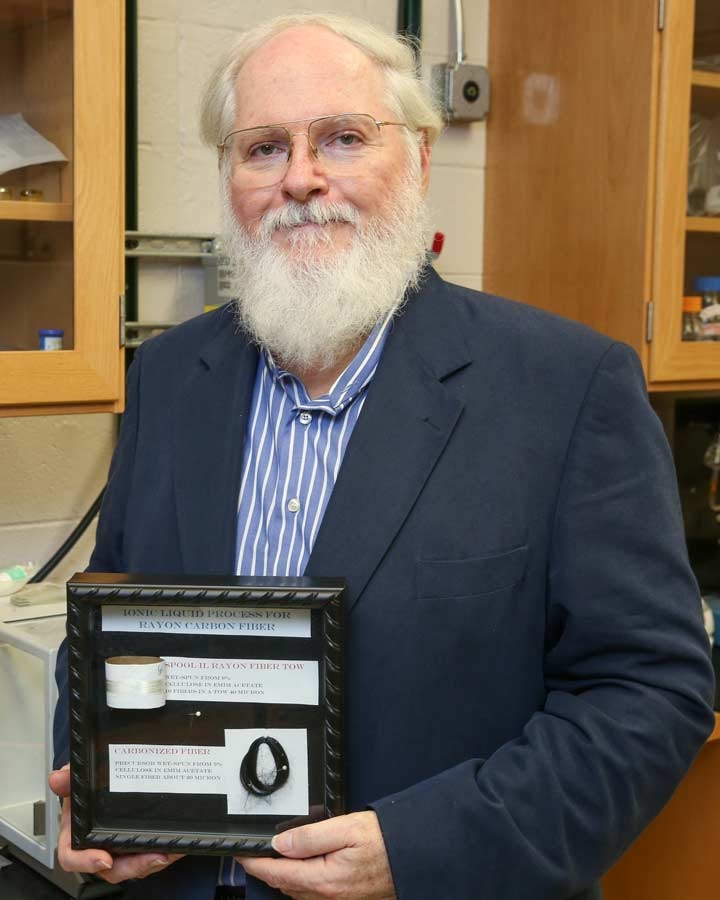Nov 4 2016
 Dr. William Kaukler with a display of the results of his work in his lab at the Reliability and Failure Analysis Laboratory in UAH’s Von Braun Research Hall. (Credit: Michael Mercier | UAH)
Dr. William Kaukler with a display of the results of his work in his lab at the Reliability and Failure Analysis Laboratory in UAH’s Von Braun Research Hall. (Credit: Michael Mercier | UAH)
A new, green method to produce the carbon fiber that forms heat shields and ablative rocket nozzles has been awarded a patent recently. The method was developed by a professor from the University of Alabama in Huntsville (UAH).
NASA with its decreasing stockpile of cellulose rayon fiber dating back to the late 1990s could benefit from this new method. Manufacturing had stopped after that period as the old method used caustics and acids which resulted in dangerous materials as byproducts.
"This is a green process, so it is environmentally clean," says Dr. William Kaukler, an associate research professor at UAH’s Rotorcraft Systems Engineering and Simulation Center and a NASA contractor for 35 years. "We recycle all the byproducts."
Funding from the U.S. Army’s Aviation and Missile Research, Development and Engineering Center (AMRDEC) helped Dr. Kaukler to develop the new green process at UAH’s Reliability and Failure Analysis Laboratory.
Other people know about using ionic processes to make fibers but they are not making carbon fibers with them. The trick was to make the properties of this fiber match the properties of the North American Rayon Corp. (NARC) fiber.
Dr. William Kaukler, Associate Research Professor, UAH
Rayon production was stopped by NARC in the U.S. after it could not financially comply with Environmental Protection Agency regulations for the dangerous wastes created.
To build a strong fuel rocket nozzle, layers of carbon fiber fabric composed of carbonized rayon are coated with pitch and wound around a mandrel, which is then heat-treated to turn the pitch into solid carbon. The nozzle that is formed would be a carbon fiber reinforced-carbon composite. Nearly 35 tons of fiber would be required for a single large solid rocket motor used for shuttle boosters. The rocket nozzles found on army missiles are made from this same carbon fiber and phenolic resin.
"This carbon fiber is not the same fiber that you’d go out and make aircraft or car parts from," says Dr. Kaukler. "This is the only way to make the carbon fiber that is suitable for rocket nozzles, is to start with cellulosic fiber."
The more common carbon fiber used in structural applications is formed using polyacrylonitrile (PAN) and, though stronger, its thermal conductivity is extremely high.
The heat produced from the rocket’s burning fuel gradually burns away the nozzle’s interior during flight.
That’s why you have to make the fiber out of cellulose, because it has the lowest rate of thermal conductivity of any fiber.
Dr. William Kaukler, Associate Research Professor, UAH
The low conductivity helps to maintain the propellant’s heat in for more propulsion efficiency and it prevents the nozzle from burning away too rapidly during flight, with terrible outcomes.
Expanding the process to manufacturing dimensions could assist NASA as it develops solid rocket motors in its next-generation Space Launch System, and it could be useful for heat shields used on planetary probes designed for landing or in re-entry to Earth’s atmosphere, Dr. Kaukler says.
"It would be useful for any aero-entry onto a planet."